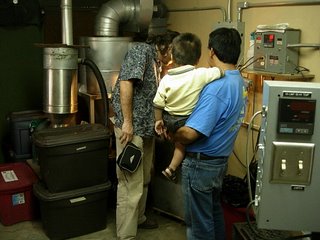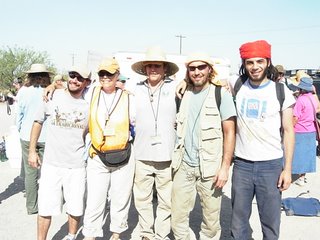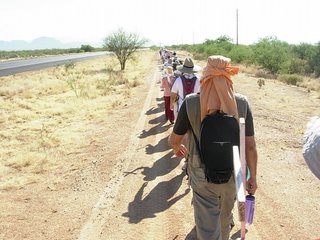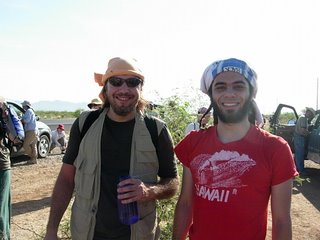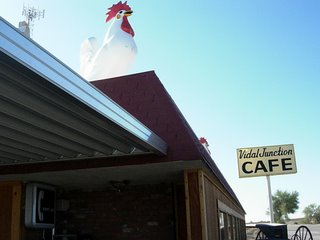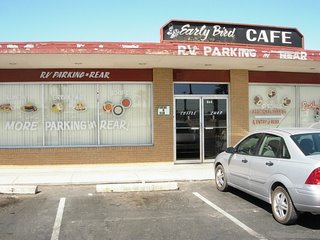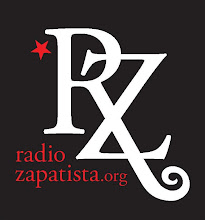por Alejandro Reyes
Yanet está muy delgada y tiene la mirada triste. Lentamente se desplaza con su andador y se acomoda con dificultad en el sofá. Tiene un pie enyesado y, en las rodillas, profundas llagas. Hablando con lentitud, llorando cuando los recuerdos se vuelven demasiado vivos, nos cuenta su historia. Y conforme habla, esta pequeña mujer va creciendo, se agiganta, y nosotros quedamos pequeños y mudos ante la fortaleza humana y la brutalidad de un sistema ciego y cruel.
Yanet salió del hospital ayer, donde pasó tres días recuperándose de lo que por muy poco podría haber sido su muerte. Como miles, millones de mexicanos y latinoamericanos, Yanet atravesó todo México desde su pueblo en la costa de Chiapas para cruzar la frontera en búsqueda de una vida digna. En la costa de Chiapas el huracán Stan a finales del año pasado destruyó no sólo los poblados, la infraestructura, las viviendas, los ranchos, sino que acabó con las fuentes de trabajo. Desempleada, sin ninguna oportunidad de salir adelante y viendo a su familia empobrecer sin remedio, Yanet decidió migrar al norte. Como tantos otros, vino a Sonora, al pueblo de Altar, el punto de encuentro de migrantes y polleros y toda la industria formal e informal del tráfico humano. De ahí, a Sásabe y a la travesía por el desierto. “Los polleros te la pintan muy bonita”, nos dice. “Dicen que es fácil, unos dos días de camino, sólo hay que llevar un garrafón de 4 litros de agua. Pero todo es mentira. A mí lo que me gustaría decirles a los que quieren venir para acá, sobre todo a las mujeres, es que no les crean a los polleros. Es muy duro.”
El clima en el desierto es inclemente y los peligros innumerables: insolación, deshidratación, hambre, víboras, coyotes, rancheros racistas, migras, helicópteros, armas, asaltantes, violaciones. Yanet tiene problemas de presión, y en las subidas sentía desmayarse. Los polleros la insultaban: “¡Ni para caminar sirves!”, le gritaban. La jaloneaban, la empujaban, y en una de esas se cayó y se rompió el tobillo.
“Nunca me imaginé que me iban a abandonar”, nos repite una y otra vez. “Nunca, nunca, me imaginé que me iban a abandonar”. Hay que estar media hora, una hora en el desierto para empezar a entender lo que significa ser abandonada allí. La inclemencia del sol, el frío de la noche, la completa ausencia de seres humanos. Todo el mes de mayo estuvo gateando por el desierto, desde el día 2 hasta el 26. Veinticuatro días sin comer, arrastrándose con las rodillas y las manos destruidas, el pie hinchado, febril, deshidratada. De alguna manera fue encontrando suficiente agua para sobrevivir: en un arroyo, en charcos inmundos que le revolvían el estómago y la hacían vomitar, en botellas abandonadas por otros migrantes en posibles redadas de la migra. En cierto momento encontró a cinco hombres, también migrantes, que trataron de ayudarla. Hicieron una camilla con una cobija, entre todos la trataron de cargar, pero no llegaron muy lejos. Finalmente, encontraron leña e hicieron una gran fogata, con la esperanza de que, al prenderla en la noche, los helicópteros de la migra la encontrarían. Se despidieron, cada quién con su destino, dejándola atrás con la soledad y la muerte en la encrucijada ética de la desesperación: salvar el pellejo significa, bajo la lógica creada por la militarización de la frontera, entregar al otro a las manos de la muerte. Me recuerda los dilemas éticos planteados por Primo Levi en sus descripciones de la experiencia de Auschwitz y su concepto de la Zona Gris, donde las víctimas son obligadas por la situación a darse la espalda, cuando no a condenarse mutuamente. La propia Yanet me dice en voz baja: “Yo creo que Dios me castigó, porque la primera vez que traté de cruzar, una mujer perdió su hijo cuando nos agarró la migra y todo mundo corrió. Ella le había dejado su hijo de cuatro años a uno de los hombres que caminaba en el grupo, y cuando llegó la migra él huyó, con todo y niño. La migra soltó a los perros, el hombre se asustó y dejó al niño y la migra finalmente lo encontró. Pero yo le dije a la señora que ella tenía la culpa, que cómo le dejaba su hijo a un desconocido. Yo creo que Dios me castigó porque entonces no entendía lo que ella estaba sufriendo, cómo es difícil caminar cuando ya no hay fuerzas y lo que debe haber sentido cuando perdió a su hijo.” Curiosamente, la condenación de Yanet hace eco inconsciente al discurso oficial norteamericano: cuando un menor muere en el desierto, los culpables son la madre o el padre. Recientemente se llegó al extremo de encarcelar a un hombre que fue atropellado junto con su hijo por un ranchero que los perseguía por el desierto. El culpable por la muerte del niño, según las autoridades norteamericanas, fue el padre, por negligencia.
La fiebre, el hambre y la deshidratación arreciaban conforme pasaban los días. De día, Yanet buscaba las escasas sombras, se enterraba en la arena, trataba de protegerse la cabeza del sol y se colocaba piedras frías sobre el vientre para calmar los dolores y los calambres. Y conforme sus descripciones avanzaban en el tiempo, se volvían más nebulosas, oníricas, delirantes, replicando el delirio de la fiebre, el cansancio y el hambre. Así es la descripción del rancho aparentemente abandonado que encontró, donde pudo beber agua y donde no quiso pasar la noche por miedo. Flotan imágenes inconexas: una camioneta con arañones, la llave de agua y sobre todo una foto, con tres hombres armados, cartucheras en la cintura y cruzándoles el pecho.
Se alejó de los ranchos que se volvían más frecuentes conforme se acercaba a la carretera, segura de que, en vez de ayuda, encontraría violencia. En la carretera, finalmente, después de 22 días de desesperación, un hombre mexicano y su hija la vieron y llamaron a una ambulancia que la llevó al hospital. Ahora está en la casa de una persona extraordinaria, una de tantas que se arriesga ante las leyes draconianas que transforman la solidaridad humana en un crimen.
Mientras Yanet habla, Sandra, sentada en un sillón, escucha con esa mirada humilde que la caracteriza. “Bueno, pero tú también tienes algo que contar, ¿verdad?”, dice Miguel.
“Sí”, responde con esa sonrisa amable, sencilla, transparente, resignada, cargada de tristeza y a la vez de determinación. “Se me murió mi bebé.”
Sandra es de Michoacán, donde vivía con su madre y sus hermanas. Trabajaba en una fábrica de Coca-Cola, donde ganaba 600 pesos a la semana, hasta que la fábrica cerró. “La renta es de 1400 pesos al mes, y mi mamá gana 1500.” Es difícil verla llorar, pero al recordar la desesperación de su familia, no puede contener las lágrimas.
Embarazada de 6 meses, Sandra decidió migrar a los Estados Unidos para poder ayudar a su madre, para que sus hermanas menores pudieran continuar estudiando, para que su hermanito de 8 meses no tuviera que pasar las penurias por las que ella ha pasado.
No nos cuenta muchos detalles, su descripción es sencilla: se nos acabó el agua, pasé dos días sin beber, me deshidraté y mi bebé se me murió dentro de la panza. Por fortuna, a ella no la abandonaron. La llevaron hasta la carretera, febril, moribunda, cuando los sorprendió la migra. Alguien le quitó su mochila con el poco dinero que tenía, una foto de su hermanito y las direcciones de sus familiares en los Estados Unidos. Y después no supo lo que sucedió: despertó en el hospital. Cuando pregunto por qué no fue deportada, la compañera que está con nosotros me explica. Cuando la migra lleva a alguien al hospital de emergencia, no regresan por él, para no tener que pagar los costos médicos.
Sandra piensa quedarse poco tiempo en Estados Unidos, lo suficiente para ahorrar un poco de dinero y ayudar a su familia. Sueña con regresar a México para enterrar a su bebé. “¿Para qué lo quiero aquí, si yo aquí no pienso regresar?”
En el transcurso de la noche, ambas recibieron llamadas de sus familiares y ambas tuvieron la noticia de que al día siguiente alguien las recogería y las llevaría rumbo a sus respectivos destinos: Oregon y Florida.
En los últimos días hemos hablado con un buen número de activistas y defensores de derechos humanos, que nos llevan a una reflexión sobre el fenómeno de la migración que es mucho más compleja que cualquiera de los debates que se llevan a cabo a nivel gubernamental en ambos lados de la frontera. Buscando, con los compañeros del Ciepac, las causas estructurales de la migración, nos enfrentamos con la coincidencia nada aleatoria entre el Tratado de Libre Comercio de Norteamérica (NAFTA) y la militarización de la frontera y, ahora, el salto sin precedentes de esa militarización y el Tratado de Libre Comercio de Centroamérica (TLCAN). La relación entre el llamado “libre comercio”, el neoliberalismo, el capitalismo desenfrenado, y el aumento de la migración, por un lado, y el endurecimiento de las posturas antiinmigrantes, por el otro, es insoslayable. En ambos lados de la frontera, los intereses económicos del gran capital articulan, de forma sistémica, procesos de exclusión, marginación y explotación de mano de obra barata que están arrinconando más y más a la gente, y llevando a los horrores cotidianos de historias como las de Sandra y Yanet. Esas historias no pueden, no deben dejar de indignarnos y de llenarnos de rabia. La pregunta es qué hacer con esa rabia y esa indignación. Para dónde canalizarla, como transformarla en una fuerza creativa.
Es esa la pregunta que se ha planteado la Otra Campaña y la Sexta Declaración de la Selva Lacandona. Cuando estuve en San Diego, al inicio de este viaje, uno de mis hermanos, con cierta perplejidad, me dijo que no entendía qué diablos quería yo con los zapatistas. Los cambios se hacen, dijo mi hermano, por medio de las elecciones, de los partidos, de los mecanismos de la democracia institucional. Hablando hace unos días con Miguel Pickard y Josete Gaya, me di cuenta de que la difícil conversación que tuve con mi familia no es sino un reflejo de las opiniones (y de la falta de conocimiento sobre el tema) de gran parte de la población mexicana.
¿Qué es la Otra Campaña? ¿Qué es el neozapatismo después de la Sexta Declaración? ¿Por qué nos importa? ¿Por qué sus ideas tienen tanta relevancia para México, para el mundo?
Este es más o menos el propósito de este viaje y de estas anotaciones. Abrir un espacio más para la palabra que los medios masivos callan o tergiversan, no sólo para aquéllos que comparten el entusiasmo por las posibilidades que el pensamiento zapatista plantea, sino sobre todo para los demás, para los que poco conocen al respecto, para los que no están de acuerdo, para los mexicanos y ciudadanos del mundo, amigos, parientes, desconocidos, para que con nuestras diferencias y desacuerdos podamos comenzar a pensar nuevas formas de pensar el mundo.
En las interminables discusiones ideológicas entre derecha e izquierda, los dos ejes sobre los que giran las soluciones y las utopías son el capital, la iniciativa privada y las leyes del mercado, por un lado, o el gobierno populista o socialista, por el otro. Y las alternativas que la democracia electoral ofrece se reducen a esos dos ejes.
Pero el zapatismo y la Otra Campaña se plantean una tercera alternativa: la posibilidad de que el pueblo, la gente, encuentre sus propias soluciones independientemente tanto del gobierno como de las grandes empresas. La base de la Otra Campaña está en el concepto de la autonomía y de la formación de redes de autonomías, y está inspirada en la experiencia de años de las comunidades autónomas zapatistas de Chiapas. Ningún gobierno tiene, hoy por hoy, la capacidad de sanar los abismos creados por el capital y las supuestas leyes del libre comercio. La única alternativa real que tenemos si queremos un cambio verdadero es la unión efectiva de todos los de abajo y la construcción de soluciones alternativas, comunitarias, autónomas, independientes. La Otra Campaña es el gran atrevimiento, la gran osadía, de saltar de la teoría a la práctica, de la utopía a la labor nada sencilla de la construcción de esa otra posibilidad.
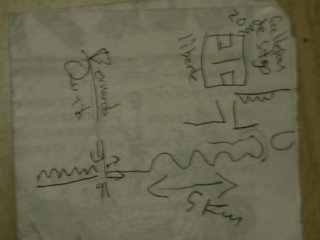 It’s supposed to represent how to get from Alejandro’s cousin’s house, on the west side of Querétaro, to Juan Pablo’s house on the east side. Somehow, mysteriously, we made it there without too many problems. Juan Pablo, Abelardo, and Mirta were there, just beginning to prepare the food. Mirta was chopping tomatoes, onions, and jalapeño chiles for pico de gallo. They immediately served us a dark, rich espresso from a percolator and told us the plan: gorditas.
It’s supposed to represent how to get from Alejandro’s cousin’s house, on the west side of Querétaro, to Juan Pablo’s house on the east side. Somehow, mysteriously, we made it there without too many problems. Juan Pablo, Abelardo, and Mirta were there, just beginning to prepare the food. Mirta was chopping tomatoes, onions, and jalapeño chiles for pico de gallo. They immediately served us a dark, rich espresso from a percolator and told us the plan: gorditas.

